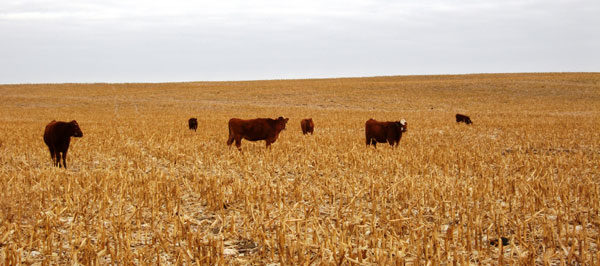Looking for additional income from your corn acres? If so, consider leasing your corn acres for cattle grazing after grain harvest.
Many crop producers have concerns that cattle trampling could negatively affect soil physical properties and subsequent crop yields. However, research conducted at University of Nebraska-Lincoln has shown that grazing corn residue at the recommended stocking rate does not reduce corn or soybean yields in irrigated fields the following growing season. In fact, a long-term study at Mead (Figure 2) showed slight improvements (2 to 3 bushels per acre) in soybean production following grazed corn residue when managed in a corn-soybean rotation. This result was the same regardless of whether cattle were grazed in the fall (November through January) or the spring (February through April).
 Figure 2. Effect of grazing corn residue in the fall/winter or spring on corn and soybean yields (2003-2013) from a field managed in an annual corn-soybean rotation at Mead. Figure 2. Effect of grazing corn residue in the fall/winter or spring on corn and soybean yields (2003-2013) from a field managed in an annual corn-soybean rotation at Mead.
|
In a 5-year study at Brule corn yields were measured after cattle had been grazed in the fall in a continuous corn field. No effect on subsequent corn yields has been observed.
It is well-documented that residue protects soil from erosion. Some corn fields, due to topography and/or low corn grain yield, should not be grazed. In most instances, excess residue can impede soil warm-up in the spring and seed placement at planting. Residue removal through grazing offers an alternative method for management of this excess residue.
About 45% to 50% of the aboveground biomass produced by the corn plant is stover (residue). For each bushel of dry corn produced, about 41 pounds of residue is also produced. Corn production of 150 bushels per acre produces about 3 tons per acre of residue; a yield of 200 bushels per acre produces a little over 4 tons of residue. Of this residue, about 40% (16 pounds per bushel) is leaf and husk, which is highly digestible and a good source of cattle feed.
Cattle are selective grazers and will eat any grain remaining first (reducing the likelihood of volunteer corn), followed by the husk and leaf.
UNL recommendations for determining stocking are based on 50% utilization of the leaf and husk (8 pounds per bushel) or about 20% of the residue (Table 1). Some additional residue would disappear by trampling and other factors such as wind loss. For most corn fields in Nebraska, there would be no increased risk of erosion if 40% to 50% of the corn residue was removed. Grazing at the stocking densities provided in Table 1 would leave plenty of soil cover.
Grazing corn residues can benefit both cattle and crop producers. Corn residue should be viewed as an economical source of winter roughage for cattle that can provide an extra source of income from corn production that does not affect next year's crop production.
| Table 1. UNL recommended stocking rates for grazing gestating cows or growing calves on corn residue | |||||
| Corn Yield bu/ac | Animal Unit Month1 (AUM)/ac | No. of 1200 lb cows per ac for 30 days | No of grazing days if stocked at one 1200 lb cow/ac | No of 600 lb calves per acre for 30 days | No of grazing days if stocked at two 600 lb calves/ac |
| 100 | 1.1 | 0.9 | 28 | 2.2 | 33 |
| 125 | 1.4 | 1.2 | 36 | 2.8 | 42 |
| 150 | 1.7 | 1.4 | 43 | 3.3 | 50 |
| 175 | 2.0 | 1.7 | 50 | 3.9 | 58 |
| 200 | 2.3 | 1.9 | 57 | 4.4 | 67 |
| 225 | 2.6 | 2.1 | 64 | 5.0 | 75 |
| 250 | 2.8 | 2.4 | 71 | 5.6 | 83 |
| 1One Animal Unit Month (AUM) is the amount of forage required to sustain a 1,000-pound cow or equivalent for one month. It has been determined that a 1,000-pound cow will consume 702 pounds of dry matter monthly. | |||||






